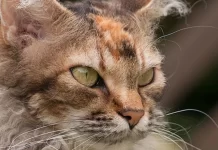Last Updated on August 18, 2023 by Fumipets
All You Need To Know About Persian Cats
Persian cats are a distinctive and elegant breed known for their luxurious long coats, round faces, and sweet personalities. Originating from Persia (modern-day Iran), these cats are characterized by their unique appearance, which includes large eyes, short noses, and flat faces.
Their thick coats come in a wide array of colors and patterns. Persian cats are known for their calm and gentle demeanor, making them popular companions for indoor living. However, their beautiful coats require regular grooming to prevent matting and maintain their health.
Persian Cats
Since the 1600s, Persian cats, one of the most well-known and beloved cat breeds in the world, have been contently cuddling with their owners. Persians are very alluring due to their large physique, long, flowing coats, and flat features.
Persian cats are a medium-sized breed that takes their responsibility as loving companions seriously. They are always available to be petted and coddled at any time. When introduced as a kitten, this lovely cat gets along with all family members, even other furry ones. She comes in a broad range of colors and color combinations. You won’t find a more affectionate friend if you’re prepared to put in the grooming effort, which is a lot of labor.
Appearance
When you see a Persian cat, there’s no denying it. These recognizable felines are distinguished by their thick fur coats, big eyes, and sturdy frames. But when you think of a Persian’s appearance, one thing comes to mind right away: their adorable, smooshy faces.
Persian cats are a medium-sized breed, weighing between 7 and 10 pounds for females and 9 to 13 pounds for males. Their eyes are usually a vivid copper, green, hazel, or blue, and they have a long, silky coat that comes in a variety of colors, including orange, grey, and cream.
Two varieties of Persian cats—the traditional, commonly referred to as the doll-face, and the show—have developed through time. Due to their resemblance to Pekingese dogs, show Persians, often known as “Peke-face,” typically have flatter features, smaller ears, thicker coats, and bigger eyes than conventional Persians.
Doll-face Persian cats are more like the earliest known photographs of the breed and have less obvious traits. But whether your cat has a Peke face or a doll face, they are both sweet-natured and need daily brushing to prevent mating of their long coats.

Temperament
Persians are as charming as they are fashionable! They are walking love sponges whose sole ambition in life is to adore you and be adored in return. These quiet, graceful beauties.
“Every cat is an individual, which means that the individual cat might not exhibit the temperament attributed to Persians,” explains Marilyn Krieger, a licensed cat behaviorist in San Francisco. In general, Persian cats are regarded as calm, sociable, and loving pets that like being handled and cuddled by their owners.
Persian cats are playful and inquisitive, but they won’t drive you crazy by prowling your house seeking water bottles to tip over. Persian cats are very strong-built, so they won’t try to scale the drapes. The most probable place to find them is curled up on the coziest pillow.
As long as they are socialised as children, they get along with everyone, including dogs. Persians don’t need continual entertainment to be happy since they are active enough to enjoy cat toys and games.
Living Needs
Persian cats may have the appearance of fashion models, but they don’t need special facilities for maintenance. In actuality, either a big house or a little flat will suit this medium-energy breed just well. Although Persian cats enjoy climbing on cat trees like other cats do, it may not always be necessary for your particular pet.
This is because not all of these cats are particularly athletic, and some Persians may prefer to keep all four paws firmly planted on the ground (or on the couch). However, they do enjoy lying in a bright window, so putting in a few cozy perches will allow your cat to watch birds in peace.
Persian cats are wonderful family companions for all ages, particularly elders and older kids because of their charming nature. Your Persian will locate any comfy lap if there is one available. Persians often get along well with both dogs and other cats.
Additionally, although your Persian will be OK left alone while you are at work (as long as she has toys and things to scratch for enrichment), Krieger advises against leaving her alone for lengthy stretches of time.
When adopting cats, she advises, “adopt a pair that is bonded to each other if at all possible.” Never leave a cat alone overnight; they need feeding, litter box cleaning, and human interaction.
Care
Persian cats need to have their rich coats brushed every day to avoid tangles and mats and to keep them in good condition. Additional dirt, dead hair, and even cat litter that might adhere to their fur can be removed by brushing and combing.
Bathing is necessary to maintain the health of your Persian’s skin and coat. Pro tip: If you begin giving your cat baths while she is still a kitten, she won’t resist being submerged in warm water as an adult. You may need to resort to spot cleaning with a warm, wet towel if you’ve adopted an adult Persian since she might not be as eager to have a bath.
According to Krieger, certain cat breeds need more attention than others, and a Persian cat definitely needs more upkeep. You should be aware of the particular care your chosen breed of cat can need before making your adoption decision.
The perfect Persian cat owner, according to her, is someone who has the time to devote to caring for their coat. She continues, “You have to brush them every day.” If not, “their fur becomes knotted. Additionally, the cat experiences pain if its fur becomes matted.
Excessive crying may also be a problem, especially in cats with flatter faces, so clean your cat’s large eyes every day to avoid stains. Persian cats also need regular dental cleanings, nail trimmings, and trips to the vet for immunizations and physicals, much like other cat breeds. Maintaining a clean litter box is also important since Persian cats may be finicky and may not use it if it doesn’t live up to their standards.
Before taking any breed home, Krieger advises completing a study on it. “New cat owners should understand everything that goes along with having a cat,” she advises before adoption.
Although Persian cats require a lot of maintenance when it comes to grooming, according to Krieger, they can be a simple pet to clicker train. Finding a treat that they enjoy and rewarding them with it when they exhibit the desired behavior are the keys, according to her. In addition to parlor tricks, they may be readily taught to avoid countertops and scratch the proper furniture rather than doors.

Health
Persians typically live between 10 and 15 years. Persian cats do have a number of possible hereditary health concerns that future owners need to be aware of. As with any breed, Persian cats are prone to specific health difficulties.
Progressive retinal atrophy (PRA) and polycystic kidney disease (PKD) are two prevalent diseases in Persian cats. Small, liquid-filled sacs develop in the kidney tissue as a result of the inherited disorder PKD, which eventually results in kidney failure. The retinal cells in cats with PRA degrade over time and ultimately cause blindness. PRA is a hereditary eye disease.
According to the American Animal Hospital Association, Persian cats, particularly those with flat faces and small jaws, are prone to eye and dental issues. Your cat’s health will be maintained better with regular care in these areas.
Persian cats should be spayed and neutered, just like other cat breeds, and should never be allowed to go outside alone.
History
Nobody is precisely sure when or when the original Persian cat appeared, but in the 1600s, people were bringing these gorgeous, long-haired animals to Europe from what is now Iran, which was formerly Persia. They were brought to Britain in the 1800s when early examples were shown at the Crystal Palace Cat Show.
The breed particularly interested Queen Victoria, who possessed six of them throughout her lifetime. One of them, White Heather, stayed at Buckingham Palace after the Queen herself had passed away. These affectionate creatures were well-liked by the British populace as a result of the Queen’s fondness for them.
In the late 1800s, the first Persian cats arrived in the United States. They were the first breed to be recognized in the newly established Cat Fanciers’ Association in 1906. By the 1950s, Persian cats with flatter faces and rounder heads had begun to emerge from selective breeding.
Persian cats have appeared prominently in works of art, advertisements, and photographs over the years due to their royal attitude and long history. In fact, Persian and Turkish Angora cats were both included in the biggest artwork of cats to ever be auctioned, My Wife’s Lovers. One of the most popular cat breeds in the United States now is the Persian.
Questions & Answers:
What are Persian cats known for?
Persian cats are renowned for their luxurious long coats, round faces, and gentle personalities, making them a sought-after breed among cat enthusiasts.
Where do Persian cats originate from?
Persian cats have their origins in Persia (modern-day Iran), where they were treasured for their unique appearance and graceful nature.
What are some distinctive features of Persian cats?
Persian cats are characterized by their large, expressive eyes, short noses, and flat faces. Their dense coats come in various colors and patterns.
What is the temperament of Persian cats?
Persian cats are typically calm, affectionate, and well-suited for indoor living. They enjoy a peaceful environment and often form strong bonds with their human companions.
Do Persian cats require special grooming?
Yes, Persian cats have long coats that require regular grooming to prevent tangles and matting. Daily brushing, particularly in the areas prone to matting, is essential to keep their coats healthy.
Please remember that Persian cats have specific needs due to their distinct appearance and coat type. It’s important to provide proper care, including grooming, to ensure their well-being and happiness.

















